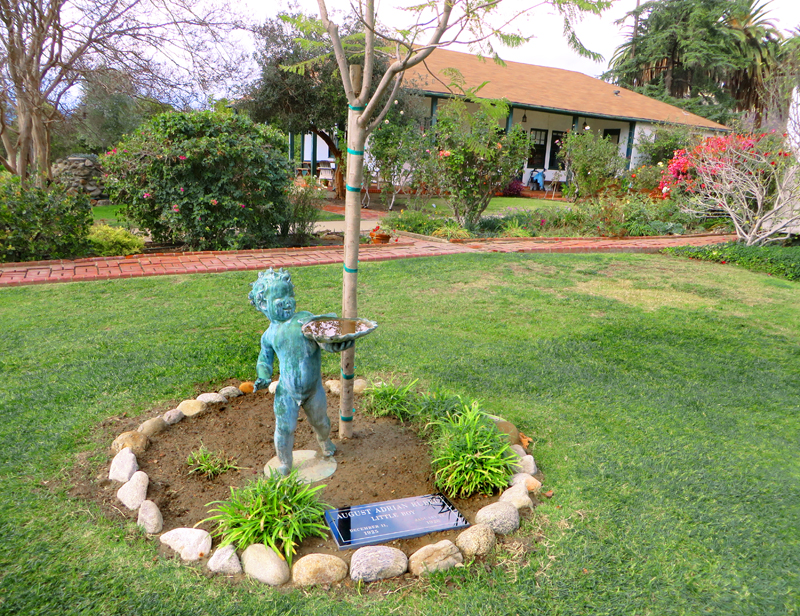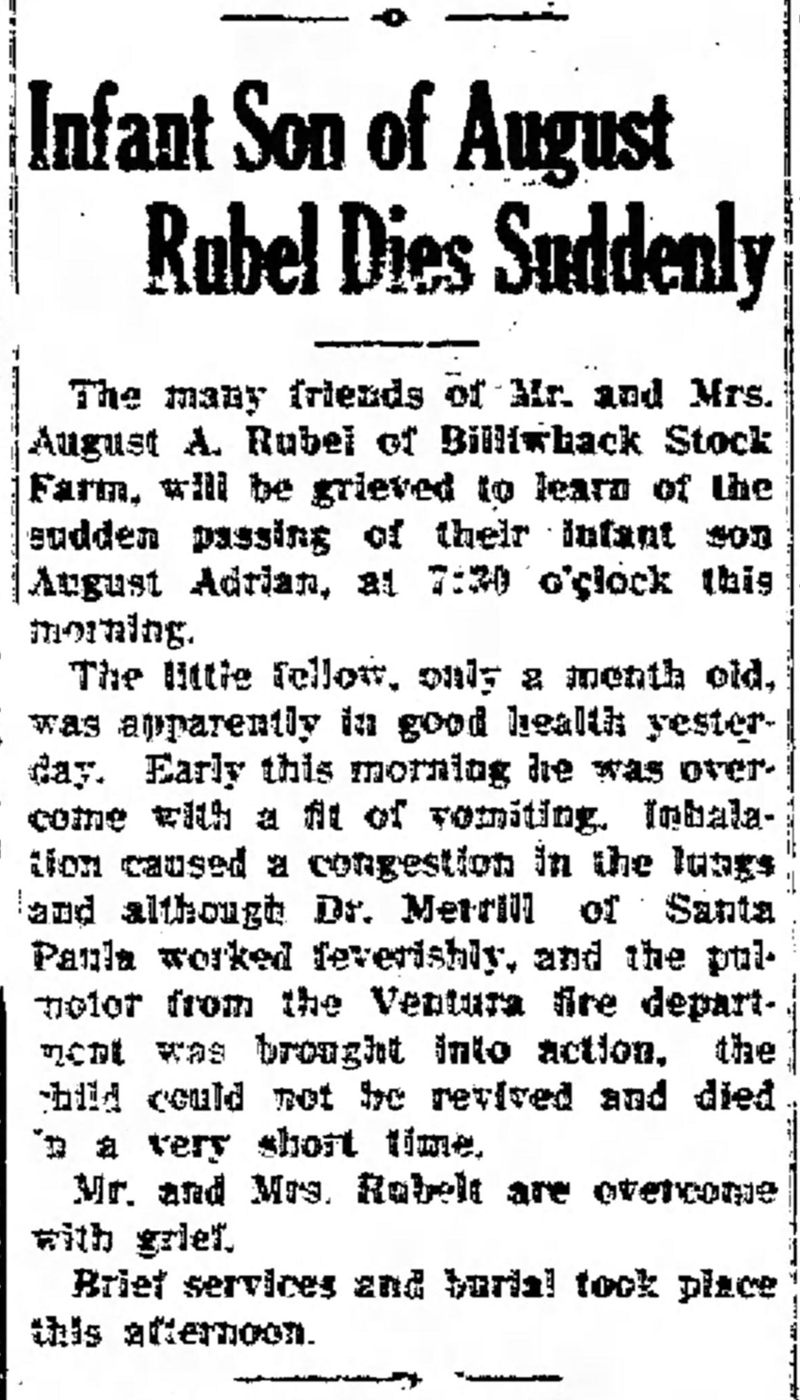|
|
Rancho Camulos

Click image to enlarge
November 21, 2013 — Brand-new headstone (installed 1 week ago) marking, for the first known time, the grave of baby August Adrian Rubel on the grounds of the Rancho Camulos Museum (10 miles west of Interstate 5 on Highway 126). Baby August lived a month, from Dec. 11, 1925, to Jan. 12, 1926. His parents were August (Sr.) and Mary Rubel, who had recently purchased the rancho. According to Shirley Rubel Lorenz, who would have been August Jr.'s little sister (she was born April 16, 1927), the family always knew him only as "Little Boy."
Infant Son of August Rubel Dies Suddenly. Oxnard Press Courier | January 12, 1926. The many friends of Mr. and Mrs. August A. Rubel of Billiwhack Stock Farm will be grieved to learn of the sudden passing of their infant son August Adrian, at 7:30 o'clock this morning. The little fellow, only a month old, was apparently in good health yesterday. Early this morning he was overcome with a fit of vomiting. Inhalation caused a congestion in the lungs and although Dr. Merrill of Santa Paula worked feverishly, and the pulmotor [respirator] from the Ventura fire department was brought into action, the child could not be revived and died in a very short time. Mr. and Mrs. Rubelt [sic] are overcome with grief. Brief services and burial took place this afternoon. News story courtesy of Lauren Parker.
In the background is the schoolhouse that August Rubel built in 1930 for his children and those of the family's bookkeeper.
According to Triem & Stone (1996) — and to his two surviving daughters in 2013, Shirley Rübel Lorenz and Nathalie (Rübel) Trefzger — August A. Rübel was a New Yorker born in Switzerland while his parents were traveling there. (Despite the umlauts, he didn't speak German, according to his daughters.) He grew up on the East Coast and served with the American Field Service during World War I, driving an ambulance in France from the fall of 1917 until 1919. Rübel attended Harvard University and came to Ventura County in 1922, first living in Aliso Canyon, four miles west of Saticoy, where he and his bride, the former Mary Colgate McIsaac, purchased a 400-acre ranch. In 1924, Rübel also purchased Rancho Camulos (pronounced kə-MOO-lōs) from the heirs of Ygnacio del Valle. The Rübels moved to the property in 1925. In April 1925, intent on developing his Aliso Canyon ranch into one of the finest bovine breeding farms in the United States (Los Angeles Times, 4/26/1925), August Rübel paid the highest price on record — $110,000 — for a 4-year-old Holstein bull named Prince Aaggie from the Berylwood Stock Farm at Hueneme. At the same time, he purchased the entire Berylwood herd (179 additional head) and gave his outfit the name "Billiwhack Stock Farm." The herd's manager, J.W. Snodgrass, came along with it. "Billiwhack" was World War I Army slang for "the place where one hangs his hat" (Oxnard Daily Courier, 4/21/1925). It's a derivation of "bailiwick." Think of it this way: If something is not your bailiwick, it is not your thing, not your place, not something you're comfortable with. Conversely, if something is your bailiwick, or billiwhack, it is your place; as a physical location, it's a place where you're comfortable. Prince Aaggie was California's undefeated champion and the world's highest yearly record butter bull. Thus his death from a twisted intestine in June 1926, just one year after his purchase by Rübel, sent shock waves throughout the livestock community and devastated his owner (Oxnard Daily Courier, 6/15/1926). Prince Aaggie was uninsured at the time of his death. Rübel had just spent an estimated $1 million on new reinforced concrete buildings, a modern refrigeration plant, refrigerated delivery trucks, and his livestock; and he had other improvements in the works when his prize bull died (The Piru News, 8/30/1928). He sold off the herd and shut down the dairy farm, which sat fallow for two years until 1928 when he sold the property to Ben Fratkin's Valley Dairy Co. of Los Angeles and El Monte. Fratkin reopened it and continued to operate it under the Billiwhack name until the early 1940s. Rübel taxidermied Prince Aaggie's head and mounted it on the southern wall of the main adobe at Rancho Camulos, where he and Mary raised five children. The AFS ambulance service was reactivated in 1939. American volunteers drove ambulances in France, North Africa, the Middle East, Italy, Germany, India and Burma, carrying more than 700,000 casualties by the end of World War II. August Rübel returned to the AFS in 1942 and was killed in Tunisia on April 28, 1943, when the ambulance he was driving hit a German land mine. He is buried in an American military cemetery in Carthage, now a suburb of Tunis. (After the war, in 1947, AFS transitioned into a student exchange program.) Mary Rübel married Edwin Burger in 1946, who continued as the resident manager of Rancho Camulos after Mary's death in 1968. Subsequently the ranch has been managed by descendants of August and Mary Rübel. The Rübel family continues to own the ranch. In fact, only two families — the Del Valles and the Rübels — have owned Rancho Camulos since 1839, when it was granted by Gov. Juan B. Alvarado to Mexican Lt. Antonio del Valle as part of the Rancho San Francisco. Today it makes a lovely setting for a wedding. The historic buildings are operated by the 501c3 nonprofit Rancho Camulos Museum, and they're open for tours on weekend afternoons. Rancho Camulos is located located just 10 miles west of Interstate 5 on scenic Highway 126. For more information visit RanchoCamulos.org. And fear not: Prince Aaggie's head is no longer on display.
LW2520c: 19200 dpi jpeg from digital image by Leon Worden. |
SEE ALSO:
Oral Histories: Mary Rübel Burger, Jaime del Valle, Glenn S. Dumke 1958
Shirley Rübel Lorenz Oral History 2002
ALSO: • Oral History 2008
Prince Aaggie 1920s
Billiwhack Dairy Can
Shirley with Bulldog ~1928
5 Church Bells 1920s
Fountain at Cocina ~1920s-30s
Shirley & Nathalie Birthday ~1931
Ranch Photos 1935
Garden Parties 1936
Del Valle Stagecoach 1938
Property Appraisal 1939
August's Library n.d.
Rübel & Carey Kids ~1940
Foreman Charlie Rycroft
August Rubel at Desk
Johnny Dingtoes
August & Gerald 1942
Double Wedding 1950s
Peter Rubel 1935-1957
Grave Marker, Baby August ("Little Boy") 2013
|
The site owner makes no assertions as to ownership of any original copyrights to digitized images. However, these images are intended for Personal or Research use only. Any other kind of use, including but not limited to commercial or scholarly publication in any medium or format, public exhibition, or use online or in a web site, may be subject to additional restrictions including but not limited to the copyrights held by parties other than the site owner. USERS ARE SOLELY RESPONSIBLE for determining the existence of such rights and for obtaining any permissions and/or paying associated fees necessary for the proposed use.
























